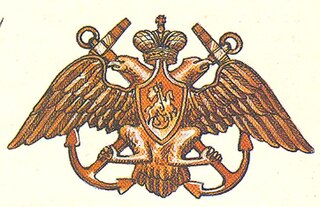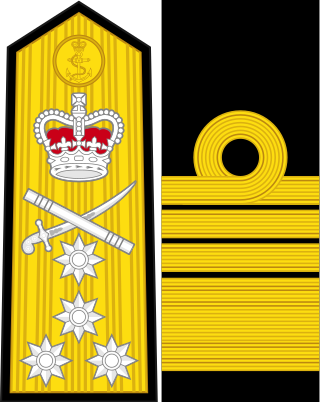Related Research Articles
Commodore is a senior naval rank used in many navies which is equivalent to brigadier or brigadier general and air commodore. It is superior to a navy captain, but below a rear admiral. It is either regarded as the most junior of the flag officers rank or may not hold the jurisdiction of a flag officer at all depending on the officer's appointment. Non-English-speaking nations commonly use the rank of flotilla admiral, counter admiral, or senior captain as an equivalent, although counter admiral may also correspond to rear admiral lower half abbreviated as RDML.

Nikolay Gerasimovich Kuznetsov was a Soviet naval officer who achieved the rank of Admiral of the Fleet of the Soviet Union and served as People's Commissar of the Navy during the Winter War and the Second World War. The N. G. Kuznetsov Naval Academy and the Russian aircraft carrier Admiral Kuznetsov, as well as the Kuznetsov-class carrier class, are named in his honor.
Rear admiral is a senior naval flag officer rank, equivalent to a major general or divisional general and air vice marshal and above that of a commodore and captain, but below that of a vice admiral.

Marshal-Admiral Marquis Tōgō Heihachirō, served as a gensui or admiral of the fleet in the Imperial Japanese Navy and became one of Japan's greatest naval heroes. As Commander-in-Chief of the Combined Fleet during the Russo-Japanese War of 1904–1905, he successfully confined the Russian Pacific naval forces to Port Arthur before winning a decisive victory over a relieving fleet at Tsushima in May 1905. Western journalists called Tōgō "the Nelson of the East". He remains deeply revered as a national hero in Japan, with shrines and streets named in his honour.
A lieutenant is a commissioned officer rank in the armed forces of many nations.

An aide-de-camp is a personal assistant or secretary to a person of high rank, usually a senior military, police or government officer, or to a member of a royal family or a head of state.

William Daniel Leahy was an American naval officer. The most senior United States military officer on active duty during World War II, he held several titles and exercised considerable influence over foreign and military policy. As a fleet admiral, he was the first flag officer ever to hold a five-star rank in the U.S. Armed Forces.

Modern Russian military ranks trace their roots to the Table of Ranks established by Peter the Great. Most of the rank names were borrowed from existing German/Prussian, French, English, Dutch, and Polish ranks upon the formation of the Russian regular army in the late 17th century.

Captain Jeremiah O'Brien (1744–1818) was an Irish-American captain in the Massachusetts State Navy. Prior to its existence, he commanded the sloop Unity when he captured the British armed schooner HMS Margaretta in the Battle of Machias, the first naval battle of the American Revolutionary War. He also led the first American attack on Nova Scotia in the Raid on St. John (1775). Six United States ships were named in his honor.

The Imperial Russian Navy operated as the navy of the Russian Tsardom and later the Russian Empire from 1696 to 1917. Formally established in 1696, it lasted until dissolved in the wake of the February Revolution of 1917. It developed from a smaller force that had existed prior to Tsar Peter the Great's founding of the modern Russian navy during the Second Azov campaign in 1696. It expanded in the second half of the 18th century and reached its peak strength by the early part of the 19th century, behind only the British and French fleets in terms of size.

Admiral is a senior rank of the Royal Navy, which equates to the NATO rank code OF-9, outranked only by the rank of admiral of the fleet. Royal Navy officers holding the ranks of rear admiral, vice admiral and admiral of the fleet are sometimes considered generically to be admirals. The rank of admiral is currently the highest rank to which a serving officer in the Royal Navy can be promoted, admiral of the fleet being in abeyance except for honorary promotions of retired officers and members of the Royal Family.

Captain is the name most often given in English-speaking navies to the rank corresponding to command of the largest ships. The rank is equal to the army rank of colonel and air force rank of group captain.

Rear Admiral Sir Godfrey Marshall Paine, was a senior officer in the Royal Navy (RN) and the Royal Air Force (RAF) in the early part of the 20th century. He played a leading role in joint and naval flying training before and during the First World War.
Staff captain is the English translation of a number of military ranks:
Lieutenant (abbreviated Lt, LT (U.S.), LT(USN), Lieut and LEUT, depending on nation) is a commissioned officer rank in many English-speaking nations' navies and coast guards. It is typically the most senior of junior officer ranks. In most navies, the rank's insignia may consist of two medium gold braid stripes, the uppermost stripe featuring an executive curl in many Commonwealth of Nations; or three stripes of equal or unequal width.

Enrique MacDonell, also spelled MacDonnell, was a Spanish admiral noted for his participation in several sea battles including the Battle of Trafalgar.

The Admiral of the North and West or Admiral of the North and Western Fleets was a former senior appointment of the English Navy. The post holder was Commander-in-Chief of the English navy's North and Western Fleets operating in the North Sea, the English Channel, the Southern Irish Sea and Atlantic from 1364 to 1414.

Rear-Admiral Donat Henchy O'Brien was an officer of the Royal Navy. He was the son of a Royal Navy captain who claimed descent from an ancient Irish king. O'Brien served as a midshipman during the French Revolutionary Wars and commanded a troop-carrying vessel during the Anglo-Russian invasion of Holland. He was afterwards appointed acting lieutenant and served as a master's mate on the frigate Hussar. While returning to England in 1804, the ship was wrecked on the Île de Sein and O'Brien and other crew were captured by the French. O'Brien was imprisoned in France but escaped in 1808 and reached a British vessel at Trieste. He later wrote a book about his experiences.
Roberta O'Brien is the highest ranking woman in the Irish navy and the first woman to captain her own ship, and then to achieve the rank of Commander.
Vice-Admiral Gerald Charles Adolphe Marescaux was a Royal Navy and British Army officer. Having joined the navy in 1873, Marescaux spent the majority of his time as a junior officer serving on surveying duties. Promoted to commander in 1896, he served as captain of ships undergoing trials at Sheerness until 1900. He was promoted to captain in 1903 and held commands at home and on the China Station before in 1910 he took command of the North of Ireland Coastguard. In 1913 he was made King's Harbour Master, Portland, and promoted to rear-admiral.
References
- ↑ Clark p.256